A wonderful Berber omelette
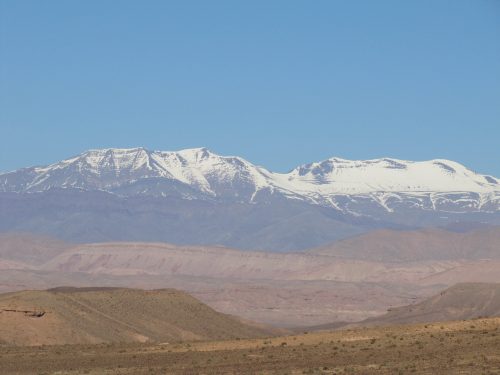
Atlas Mountains, Morocco
On our last morning in the Dades Valley on our tour of Morocco, we had a wonderful treat for breakfast. Our tour guide was up early, scouring nearby farms for enough eggs to make us a genuine Berber omelette. Genuine or not, it was delicious, made even more palatable by the alleged effort made to procure the ingredients. I am not a great fan of omelettes at the best of times, but this treat was far superior to any other omelette I had ever tasted. It was followed by a delicious pancake.
While on our trip through Morocco I discovered that I had a palate that was far more adventurous than I thought. I was actually looking forward to experiencing the many tastes of Morocco as well as the scenery, the people and of course, the architecture. I was not disappointed on this trip – and we still had Spain ahead of us on this trip.
After our long walk along the Dades Valley the day before, we were pleased that the next day was mainly occupied in transit while sitting on the bus. When we left the Dades valley we drove along the Roses Valley, so-called due to the plentiful rose plants surrounding many of the fields. Locally, rose water and perfumes are made and sold at many outlets. At one of our stops, even my wife succumbed to lure of these local delights.
We travelled the Road of a Thousand Kasbahs towards the town of Skoura. Along the way, we passed through some desolate country which is shown in the photos on today’s post (see below). At certain points, we had distant views of the snow-capped Atlas Mountains, a spectacular range we would traverse later in our tour.
In the desolate areas, there were wide expanses of stony country and from time to time we passed a few hardy nomadic Berbers following their traditional ways. At one point, our guide astounded us by a little piece of Australia on the roadside. Several thousand hectares of the desolate land had been planted with Australian saltbush in the 1990s. This was supposed to provide extra food for the sheep and goats of the local shepherds. The plantations were abandoned after protests from the local people, but there is still some evidence on the plantations (see photos below).
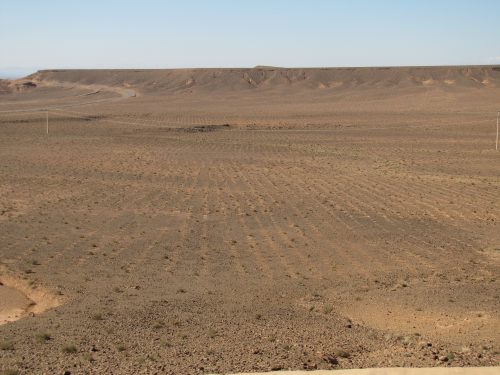
Australian saltbush plantation in Morocco
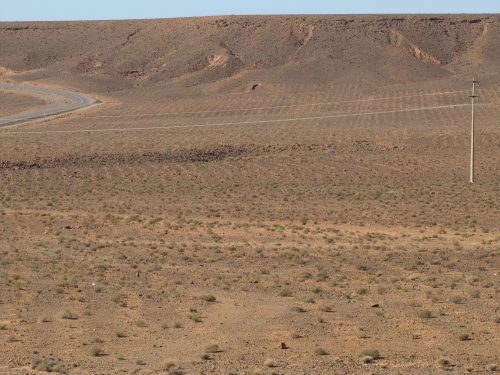
Australian saltbush plantation in Morocco
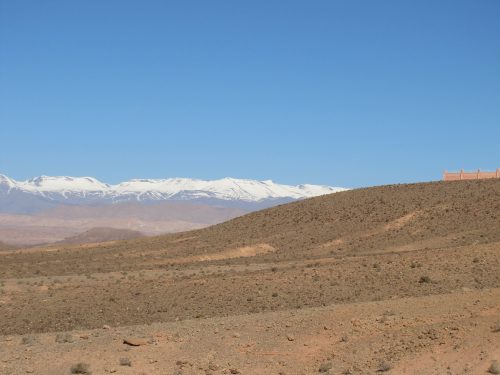
Atlas Mountains, Morocco
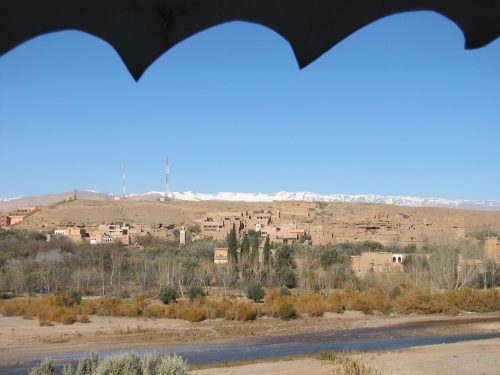
In the distance the Atlas Mountains, Morocco
Architectural contrasts in Morocco
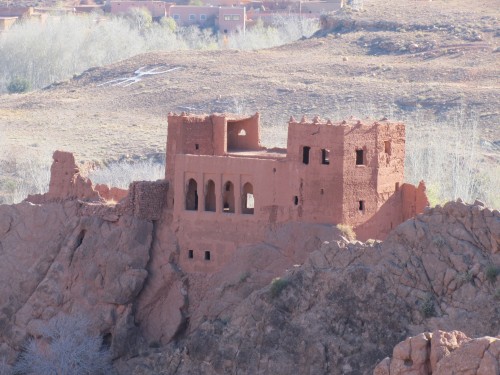
Old kasbah building in the Dades Valley
Over recent weeks, I have been sharing many of my photos taken during a tour of Morocco. You can look back through these posts to read them, or you can use the archives to search for them – the link is above the title of this post.
Kasbahs
Over the two weeks of our tour, we saw many magnificent buildings, especially those featuring mosaic tiles. These really caught our attention and we enjoyed visiting such buildings. Part way through our tour we spent two nights in the Dades Valley, a predominantly Berber region of the country. Here the architecture was quite different, as shown in today’s photos. One part of this area is the is known as the Road of the Thousand Kasbahs on which we travelled on our way to Skoura.
Adobe buildings
One of the architectural features of this region is the adobe buildings of the Berbers, as shown in today’s photos. These old kasbahs are mud structures, either made from mud-bricks or rammed earth. (If this is wrong, could my readers please enlighten me. Our guide was not forthcoming on this matter, and I didn’t ask.)
Many of the old kasbahs are no longer inhabited. A more modern building style in this area is also shown below. It may also be made from mud bricks, but the outer walls have a rendering which makes it look very stylish indeed. I suspect that this modern home may also have been made using local stone which is plentiful in this mountainous region of the Atlas Mountains.
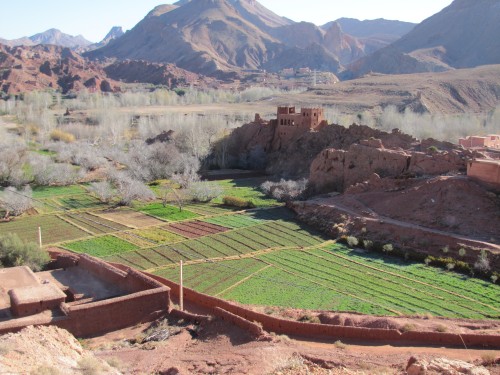
Old buildings in the Dades Valley set in farming country
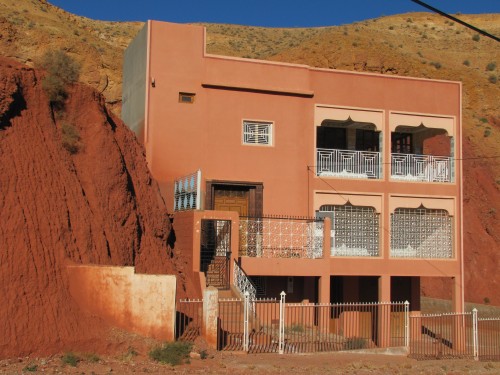
Modern building in the Dades Valley
Dades Valley in Morocco
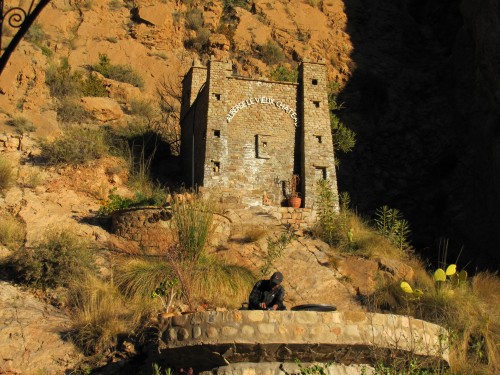
Opposite our hotel in the Dades Valley
Over recent posts, I have been describing our experiences in the Dades Valley of Morocco. During our two-night stay in the Hotel du Vieux Chateau du Dades I never found out what the structure shown in the photo above was meant to be, or why it was there – apart from being advertising for the hotel where we stayed, which was across the road. It was similar to several other buildings nearby, so it could well have been simply an example of the typical local architecture. The builders obviously used the common building material available at this location. Further down the valley, the predominant building material was mud, as seen in the last few photos below.
A great breakfast feast
Our tour guide, Said, promised us a Berber omelette for breakfast. He came good on this promise. On the downside, however, he reported at breakfast time that he had been up very early that morning scouring the neighbourhood for enough fresh eggs to make omelettes for the whole group. I am pleased that he went to the effort because the result was delicious. They were actually cooked in tagines and I can still remember the taste sensation. Mine was followed by indulging in a delicious pancake.
We travel on
After breakfast, we packed the bus and headed off down the Dades Valley road towards the Road of the Thousand Kasbahs and the Rose Valley. Along this stretch of road, I took the photos shown today mostly from the bus window though we did stop several times at lookouts along the way.
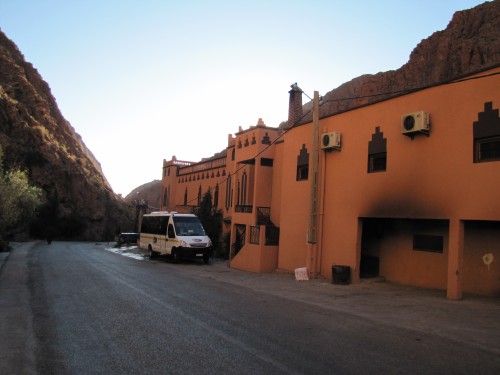
Our hotel in the Dades Valley. Our tour bus is also in the photo.
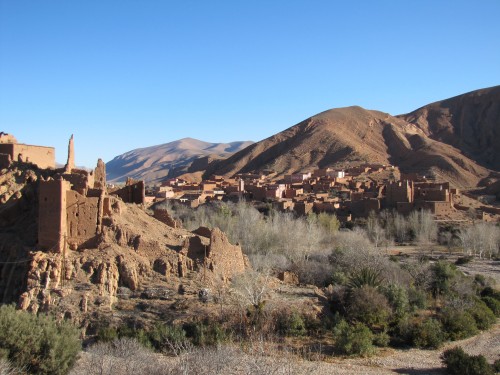
A scene along the Dades Valley road.
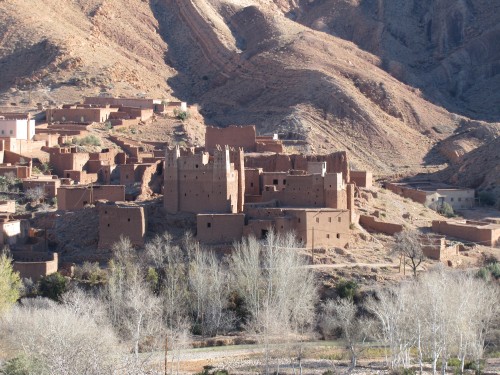
A scene along the Dades Valley road.
The Dades Valley in Morocco
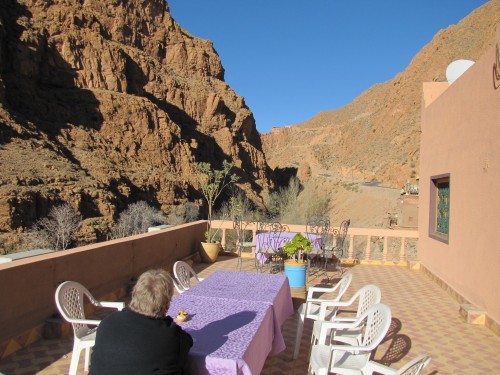
On the terrace of the Hotel du Vieux Chateau du Dades
After our long four-hour walk down the Dades Valley – I wrote about that in my last post – we had a delicious lunch in the sunshine on the terrace of the Hotel du Vieux Chateau du Dades. Being at a high altitude in the Atlas Mountains, the air was cold and crisp. Sitting on this terrace (shown in the photo above) we enjoyed the warming sun as we ate. The surrounding cliffs gave a very grand view as we ate.
Enjoying the sunshine
After lunch, most of our touring party decided to walk up the road for half an hour to have coffee near the top of the pass on the road leading north. My wife, daughter and I were too tired from the morning walk to contemplate more walking, so we stayed behind, enjoying the last of the weak afternoon sunshine. After the sun went behind the nearby cliffs, we retreated inside quickly to the warmth of the fireplace at one end of the restaurant.
A warm fireplace
The fireplace was also popular with other guests of the hotel and it was a matter of taking it in turns to get warm. I must say that all in our family really enjoy an open fire. The high cost of firewood makes this increasingly expensive in Australia, but we are pleased that we have a limited supply of firewood on our own property at our home in South Australia. We always have to supplement this with firewood bought from a dealer.
Writing
All through our six-week trip, I kept a diary, and parts of these blog posts originate from my diary. So in the evenings, I often spent a half hour or so updating my diary. I also decided before leaving home that I would emulate the achievement of a friend of mine. On an overseas trip, she decided to capture her impressions of her journeying by aiming to write at least one poem a day. I achieved my goal. My friend has since published some of these poems in book form. That joy still awaits me – stay tuned because that is in my plans too. Sitting near to the fireplace in our hotel was an ideal writing spot. Chatting with fellow travellers was another delight.
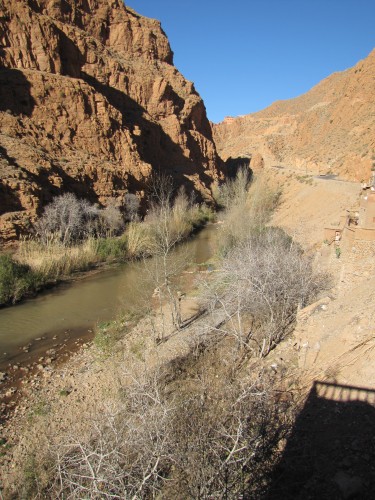
The view up the Dades Valley from the hotel terrace.
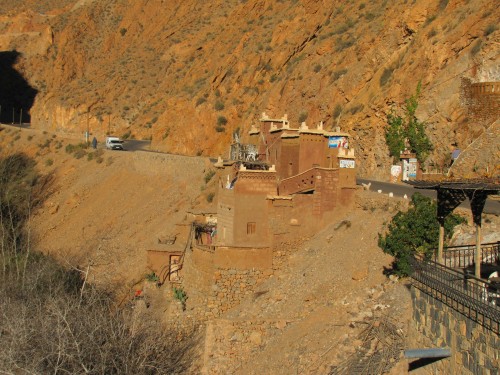
The view up the Dades Valley from the hotel terrace.
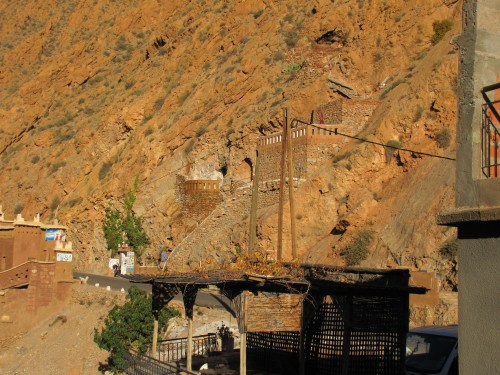
The view up the Dades Valley from the hotel terrace.
A walk through the Dades Valley
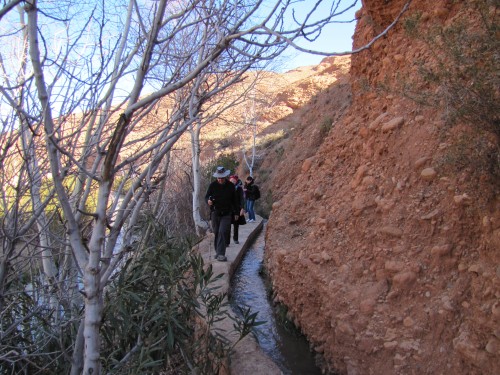
Part of our walk in the Dandes Gorge
After our visit to the carpet and rug shop in Tinghir in Morocco, we headed off in our tour bus to our accommodation in the Dades Gorge for the next two nights. We stayed in the Hotel du Vieux Chateau du Dades.
This hotel appeared rather non-descript from the outside, but once inside we appreciated the warm and welcoming atmosphere, especially the warm fire in the dining room. To be honest, the rooms were very cold but then, we were staying at a high altitude so that part was understandable. (In my diary written at the time, I recorded that it was over 2000 metres in altitude, but I think that must be a little off the mark. Although the surrounding peaks can rise as high as 2,700 metres, we were in a valley. The hotel we stayed in was somewhat high in that valley, but I doubt that it stood at over 2000 metres.)
On our arrival we settled into our rooms, showered and changed for dinner. Before that, we had been in our clothes for about 36 hours, sleeping in them in the Sahara the previous night. For dinner, we enjoyed a delightful couscous. One of the major highlights of travelling in Morocco was experiencing their foods. We were never disappointed. We slept reasonably well despite having to run the air-conditioner all night just to keep warm.
A long walk
After a wonderful breakfast, we set off walking down the Dades Gorge. This hike took us through several Berber villages along the way, though we did not see many people. I found that the walk was very interesting but I was disappointed not to see and photograph many birds. Along the way, we came across a shepherd watching over his sheep and goats on the hillside (see the photo below).
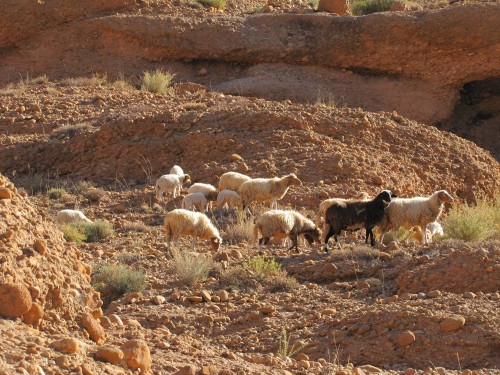
A shepherd was watching over his sheep and goats as they grazed.
At the end of our trek we had one final challenge: a very unstable and rickety bridge over the river. I have included a photo below, taken AFTER I had successfully crossed over. We actually had a choice: cross on this bridge – or walk back up the valley for another four hours to our hotel. Not really much of a choice, in the end. As it turned out, by crossing one at a time, we all successfully negotiated the bridge. Locals probably do it every day without thinking.
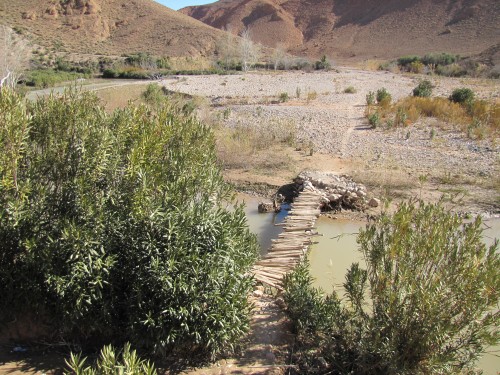
You call that a bridge?
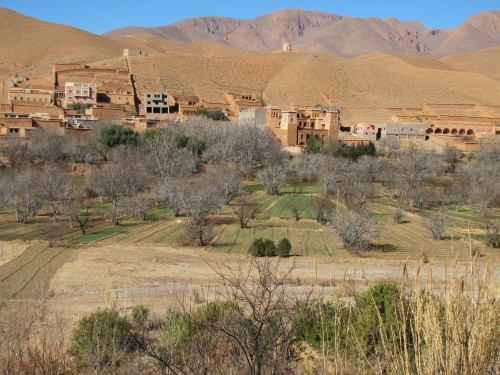
In the Dades Valley